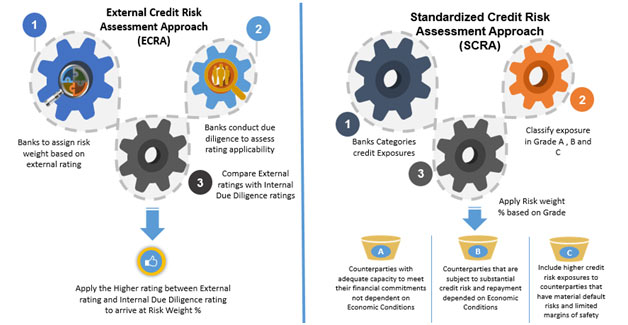Business
Demystifying Revised Credit Risk Standardized Approach

Credit Risk is one of the major traditional risk that is actively managed by Banks across geographies .With Changing times the Credit Risk Regulations too have undergone tremendous changes .Regulations such as Basel I bought in some standardization in which credit risk was measured and reported, as times progressed and the framework matured regulations such as Basel II and Basel III saw a more risk sensitive approach towards measuring credit Risk. Post the Financial Crisis, Global regulators started issuing many regulations to contain and control various risk types. As the regulatory agenda has nearly firmed we see a focused rigor from regulatory bodies to ensure standardization and comparability across numbers that are reported by Banks for various risk types ,in line with the thought process we are a seeing many new regulations and also enhancements to existing frameworks which are trying to attempt this .In 2015 ,Bank for international settlement (BIS) came up with a revised standardized approach for credit risk as a successor to existing Basel III Credit Risk framework .Since then through various consultations this standard has undergone numerous changes and is finally zeroing in on an implementation date of Jan 2022.
If we were to get in to basics of credit Risk, It emanates when bank accepts deposits from its depositors and lends the same to its customers who can be sovereigns, corporates or retail customers. This activity creates an exposure for the Banks which can result in a potential loss if the borrower is unable to repay the debt in full or in part.
The image below provides a summarized view of how the Basel Risk Framework has evolved till date

Figure 1 – REVISED STANDARDISED APPROACH
The revised Standardized approach for credit risk was introduced with the following main objectives
- Reduced Dependency on external ratings agencies – External Rating agency plays a critical role in determining credit risk of the counterparty. Mechanical reliance on external ratings without any due diligence will lead to non- prudent risk management. By introducing the due diligence process bank has reduced dependency on External rating agencies
- Increased comparability across banks and jurisdictions:Though there are several implementation options at regulator’s discretion, the new standards will considerably aid in comparability between Banks and Jurisdictions.
- More focus on risk sensitivity& granularity – The revisions introduce newer asset classes and additional credit risk assessment within the framework, which will help in arriving at more prudent estimates of RWA and regulatory capital
- Dynamic Risk Weights –The Risk Weights as prescribed in current standardized approach are in line with the current economic conditions.
This approach sees introduction of two approaches namely
- External Credit Risk Assessment Approach (ECRA) – ECRA is applicable for rated exposures of banks in jurisdiction that allow use of External Ratings for regulatory purposes. Banks adopting this approach will also have to set up a Due Diligence framework to assess the rating applicability
- Standardized Credit Risk Assessment Approach (SCRA) – SCRA is applicable for countries where external ratings are not permitted, banks would classify exposures into three buckets (A, B and C) based on assessment of borrowers’ ability to pay and derive RWA accordingly

Figure 2 – REVISED STANDARDISED APPROACH – CREDIT RISK
In terms of implementation, the Revised approach will have an impact on the below dimensions
- Capital requirements- likely to increase for banks of varying sizes due to additional due diligence requirements and conservatism.
- Data and Reporting– The revised guide line will require Additional data elements to be sourced and newer Data interfaces to be established along with adequate Quality Controls for computational as well as reporting needs. Due Diligence requirements will also require vast amount of Data for Banks which are following the ECRA approach.
- Computations – Rules for RWA computation would depend on the approach followed in each country rather than directly external rating. The below table provides a summary of impact of
| Exposure Class | Current Standardized Approach
|
Revised Standardized Approach |
| Sovereigns | Mapping to external agency ratings and Export Credit Agency (ECA) scores and assign RW | No Change. current Approach is continued |
| Public Sector Entities | Mapping to external agency ratings and Export Credit Agency (ECA) scores and assign RW | One category less favorable risk bucket than sovereigns. Mapping to external agency ratings and Export Credit Agency (ECA) scores and assign RW |
| Multilateral Development Banks (MDBs) | Basic differentiation between the MDBs that have high-quality long term issuer ratings and other short term issuer rating | Due diligence of MDB counterparty is required along with existing approach |
| Banks
|
One category less favorable risk bucket than sovereigns (long-term and short-term claim distinction) or credit assessment of banks | Introduced 2 approaches:
ECRA: where national supervisor allows banks to use External ratings. SCRA: for rest of the banks and for unrated exposures. Grade Based on Minimum Capital requirement along with Buffer capital. Banks to carry out Due diligence of the customer credit worthiness. Outcome of due diligence factor should be considered while applying RW |
| Corporates | Mapping to external rating agency and assign RW. Also at national discretion, supervisory authorities may permit corporate claims to receive 100% Risk Weights without regard to external rating. | Bank has two options:
Ø Where national supervisor allows banks to use External ratings, apply base RW based on rating Ø Else apply 100% RW if corporate is not Investment grade or Corp |
| Specialized Lending | No separate treatment from the corporate exposures | Exposure is Classified into 3 categories
1. Project Finance 2. Object Finance 3. Commodity finance Where national supervisor allows banks to use issue specific external ratings, apply base RW based on rating Else apply 100% RW for Object and commodity finance and 130% for Project Finance during pre-operational period and 100% during operation period |
| Subordinated Debt, Equity and Capital Instruments | Investments in equity or regulatory capital instruments issued by banks or securities firms is risk weighted at 100% | Ø For speculative unlisted company RW 400%
Ø For Other Equity holding RW = 250% Ø For subordinated debt and capital instruments other than equities RW 150% |
| Retail Exposures | Risk-weighted at 75%, except for pastdues | Differentiation between the
Regulatory Retail (75% Risk Weight) and Other Retail (100% Risk Weight) exposures |
| Residential Real Estate | 35% Risk Weight | LTV Ratios and the characteristics of repayment (if materially dependent on cash flows generated by property) are considered for deriving RW. |
| Commercial Real Estate | 100% Risk Weight as per Basel | LTV Ratios and the characteristics of repayment (if materially dependent on cash flows generated by property) are considered for deriving RW. |
Challenges in implementing Revised Standards:The revised standards will also bring in below challenges for the Banks –
- Complexity and granularity of regulation requirement will increase extensive implementation effort
- Revised approach involves extensive data requirement such as data on residential and commercial real estate collateral etc.,
- Banks and financial institutions applying the ECRA approach have to introduce new due-diligence framework for assessing the counterparty credit worthiness independent of using external rating agency data.
- Need to re-align the business model and strategies as the revised approach will potentially result in an increase in RWA and capital requirements
The Revised standards will also have Cross Program impacts especially with initiatives around Default Management and Pillar III disclosures. Also many Banks have already started initiatives to focus on the revised standards so that they are better prepared to comply with the Jan 22 deadline and are also using Traditional Technologies as well as newer Digital technologies (like AI,ML & RPA etc.) to overcome the implementation challenges.
About the Author:

Venkatesh A S
Venkatesh A S is a Chartered Accountant by profession. In his current position as a Domain Consultant with Risk Management and Compliance Practice of Banking, Financial services & Insurance (BFSI), a business unit of Tata Consultancy services. He has Rich and Extensive experience of 18+ years in consulting, implementation and solution design in regulatory compliance projects like Basel A-IRB, SACR, CVA, IFRS 9 etc., and has worked extensively with several banks and financial institution across Geographies.

Ajay Katara
Ajay Katara is a Domain Consultant with the Risk Management practice of the Banking and Financial Services (BFS) business unit at Tata Consultancy Services (TCS). He currently heads the Solution and Strategy for Enterprise Risk and Compliance Regulations. He has extensive experience of more than 14 years in Consulting & Solution design space cutting across CCAR Consulting, AML, Basel II implementation and credit risk, and has worked with several financial enterprises across geographies. He has significantly contributed to the conceptualization of strategic offerings in the risk management space and has been instrumental in successfully driving various consulting engagements. He has also authored many editorials, details of which can be found in his linked in profile (https://www.linkedin.com/in/ajaykatara/)

-
Top Stories4 days ago
Dollar jumps, yen weakest since 1990 after strong U.S. retail sales
-
Business4 days ago
How Businesses Can Enhance Employee Work-Life Balance and Well-Being
-
Business3 days ago
docStribute appoints ex-Group CIO of Newcastle Building Society as Non-Executive Director
-
Technology3 days ago
How to Use AI to Optimize Customer Relationships







